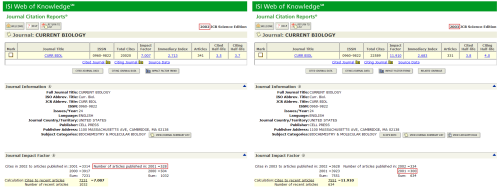Main Menu
Welcome
All around the world, from grant funding to the peer review, publication, reproduction and public dissemination of research results, elite scientific journals wield huge influence and control over just about every facet of scientists' lives.
[...]What matters is both the extent of production as measured by the number of publications and how brilliant the publications are held to be as measured by citations, the number of times academic work is cited by peers. Papers in top journals are more likely to be cited, and so scientific life becomes geared to chasing publication in elite journals with the highest impact factor and high performances in a complex array of journal metrics.
[...]The norm is for scientists to start at the top - submitting papers to the most prestigious journal that they think they might have the remotest chance of getting into - and then working their way down until they are eventually selected. Journals become a means to academics' ends.
[...]the system puts pressure on scientists to act in ways that adversely affect science - from claiming work is more novel than it actually is to over-hyping, over-interpreting and prematurely publishing it, splitting publications to get more credits and, in extreme situations, even committing fraud.
[...]"The incentive for me is to cut off completely parts of the world that have the biggest health challenges ... citations create a racist culture in journals' decision-making and embody a system that is only about us (in the developed world)."
[...]The problem, he explains, is that because so much hangs on whether a journal takes a particular paper, researchers live in constant fear of "irritating the editor". Scientific conferences become elaborate courtship rituals as scientists try to demonstrate that they are leaders in the field to ensure that their papers are looked at when they are submitted. "One's entire fate is in the journal's hands," Lawrence says.
[...]Horton's concern is the way journals control the media. He is highly critical of journals presenting scientific findings to journalists under embargo. Hyping science as an "event" misrepresents the real nature of the endeavour as a gradual accumulation of knowledge and understanding, he asserts.
[...]According to Smith, one of the most unfortunate consequences of the elite journals' power is that they are holding back progress towards open access, the alternative publishing model where papers are free for the public to read, but publishing and peer-review costs (which all parties agree are substantial) are paid by funders.
[...]"Journals are getting rich off the back of science without, I would argue, adding much value." Publishers, he says, take scientists' work, get other scientists to peer review it for free, and then sell the product back to scientists' institutions through subscriptions.
And the best one: if the situation continues, journals will die - and deserve to. Quite honestly, if that is all journals are - a production line for the scientific community - you don't need journals in the internet age, you just need a big database.
And then, what did my little eyes spy? I caouldn't believe it, James Testa, vice-president (editorial development and publisher relations) at Thomson Reuters, claiming that their Impact Factor is non-negotiable and transparent:
While we respect publishers' interest in understanding these determinations, the content of the denominator is never negotiated or altered to suit their requests. Millions of subscribers to the Web of Science website can easily view the items included in the denominator. This information is thus widely available and fully transparent.
Well then, Mr. Testa, let's have a look at the denominator for the journal Current Biology in the year 2001 (click to enlarge):
Of course it is entirely understandable and transparent how it's even possible to have two numbers for the denominator of the same year! BTW, the year 2001 is when Current Biology was bought by Cell Press (Elsevier). That of course had no influence in this strange duplicity of numbers? Pure coincidence? Honi soit qui mal y pense!

Posted on Thursday 13 August 2009 - 17:03:43 comment: 0
{TAGS}
{TAGS}
You must be logged in to make comments on this site - please log in, or if you are not registered click here to signup
Render time: 0.0864 sec, 0.0063 of that for queries.





